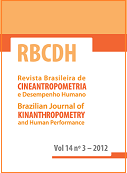Performance comparison of resistance-trained subjects by different methods of adjusting for body mass
DOI:
https://doi.org/10.1590/1980-0037.2012v14n3p313Abstract
The aim of this study was to compare the performance (1RM) of resistance-trained subjects, using different methods of adjusting for body mass (BM): ratio standard, theoretical allometric exponent (0.67), and specific allometric exponents. The study included 11 male and 11 female healthy non-athletes (mean age = 22 years) engaged in regular resistance training for at least 6 months. Bench press (BP), 45° leg press (LP) and arm curl (AC) exercises were performed, and the participants were ranked (in descending order) according to each method. The specific allometric exponents for each exercise were: for men – BP (0.73), LP (0.35), and AC (0.71); and for women – BP (1.22), LP (1.02), and AC (0.85). The Kruskal-Wallis test revealed no differences between the rankings. However, visual inspection indicated that the participants were often classified differently in relation to performance by the methods used. Furthermore, no adjusted strength score was equal to the absolute strength values (1RM). The results suggest that there is a range of values in which the differences between exponents do not reflect different rankings (below 0.07 points) and a range in which rankings can be fundamentally different (above 0.14 points). This may be important in long-term selection of universally accepted allometric exponents, considering the range of values found in different studies. The standardization of exponents may allow the use of allometry as an additional tool in the prescription of resistance training.



